
yarn evenness tester
Visual determination of unevenness along the length of a yarn is carried out by wrapping it in equally spaced parallel wraps over a board and comparing the appearance of irregularities against standard rating photographs. To enable yarns of different thickness to be assessed, the spacing between the warps is suitably selected so as to give a clearly distinguishable pattern.
...more
Universal Force Table
For experimentally verifying the laws of triangle, parallelogram and polygon of forces Comprising of a equal circular 40 cm, dia aluminium disc, graduated into 360 divisions (degree), complete with levelling screws, clamping device to fix the table at any desired angel, five sliding clamp pulleys, central ring, string and five sets of iron nickelled slotted weights, each set containing nine weights and one hanger of 50 gm.
...more
Unconfined Compression Test Apparatus
Unconfined Compression Testing Apparatus can be used either in a Laboratory or in field. This apparatus is as per the design of Building Research Station, U.K.Consists of a spring operated load frame with arrangements for loading 38mm x 76mm samples, one set of four load springs of stiffness 0.2kg, o.4kg, 0.8kg and 1.6kgmm, a calibrated mask and one set of 50 charts, in a metal carrying case. Spares & Accessories: Charts set of 50 Calibrated mask. Spring set comprising one each of stiffness 2Nmm, 4Nmm, 8Nmm and 16Nmm Coning toll for 38mm sample (female) Coning toll for 38 mm sample (male) Tripod stand wooden, for using the instrument in field.
...more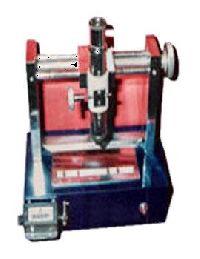
Traverse Thread Counter
One of the most common measure of the quality of a fabric is the number of threads per unit length in both the warp and weft directions, or its picks and ends. Picks and ends of any fabric are normally determined with the help of an ordinary counting glass having a square or rectangular opening of specified size. However, when a greater degree of accuracy in determination of picks or ends is needed, or the weave is too fine to be checked with an ordinary counting glass, this counting is carried out with the help of a traverse thread counter. In this apparatus a traveling microscope is used for viewing the weave of the fabric under test. Openings of known widths are provided to enable picks and ends per unit length to be determined, both in metric and imperial systems
...more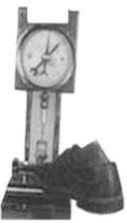
Sole Adhesion Tester
The strength of adhesion of a sole to its upper is determined by measuring the force needed to pull off the sole from the upper. A suitable last is placed inside the shoe, which is then placed on a straight edge acting as a fulcrum for applying load on the joint of the sole and upper. The maximum load the sole can withstand before coming off is determined and reported as the sole adhesion strength. This test can be carried out either at the heel or at the toe of the shoe.
...more
Shrinkage Bar Mould
The mould, which has 25mm x 25mmx 250mm. effective gauge length is made of mild steel and has accurately machined faces. The parts of the moulds are tight fitting and firmly held together when assembled. Supplied complete with base The mould is used for casting specimens of cement aggregate combinations fro measuring the potential expansive alkali reactivity.
...more
Pipe Friction Apparatus
Two G.I. Pipe lines of size 20 & 25mm with tapings at 2m having a set of individual gate valves & distribution chamber with isolating cocks to facilitate individual experiment on piping system
...more
Petrol Engine Test Rig
Three main components from main parts of the test rig. Welded steel base plate, complete with Mechanical Brake or A.C. Alternator or D.C. Generator or Eddy Current Dynamometer, Drive coupling and with safety guard, anti vibration mounting. Resistance loading with selector switches to the engine from no load to full load (Only for A.C. Alternator & D.C. Generator) Panel board positioned over the base plate consisting of fuel system with flow measurement by burette, air flow measurement system, temperature indicator.
...more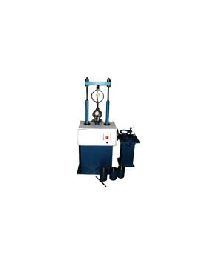
Marshall Stability Test Apparatus
Originally developed by Bruce Marshall, a highway engineer in U.S.A later on standardized by ASTM. Generally the test is applicable to hot mix designs using bitumen and aggregates upto a maximum size of 25mm. In this method, the resistance to plastic deformation of cylindrical specimen of bituminous mixture is measured when the same is loaded at periphery at 5cm per min. This test procedure is used in designing and evaluating bituminous paving mixes. The test procedure is extensively used in routine test programmers for paving jobs. There are two major features of the Marshall method of designing mixes namely. a) densityvoids analysis, b) Stability-flow tests. The Marshall stability of mix is defined as a maximum load carried by a 0 compacted specimen at a standard test temperature of 60 C. The flow value is deformation the Marshall test specimen at under goes during the loading upto the maximum load, in 0.25 mm units. In this test and attempt is made to determine optimum binder content for the type of aggregate mix and traffic intensity.
...more
Longitudinal Compressometer
It is designed for finding out the deformation and strains on 15cms. Diameter and 30cms high cement concrete cylinders when subjected to compressive loads. Consists of a frame with a bottom ring and a top ring with tighteningscrews to firmly clamp the compressometer over the cylinder.
...more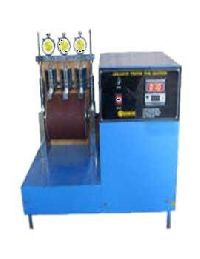
leather testing equipment
The resistance to abrasion of sole leather may be determined with the help of a drum type abrader (similar to NBS Abrader). In this test, an abrasive cloth strip of a specified grit is fixed over the circumference of a drum, which is rotated at a specified speed. The test specimen, in shape of a rectangular strip, is held on a metallic bar located above the drum such that its longer axis is perpendicular to the axis of the drum. When the metallic bar is pressed against the drum, the test specimen gets abraded. The number of revolutions needed to produce a depth of abrasion of 2.5 mm is determined and compared against that needed to produce a depth of abrasion of 2.5 mm in a standard rubber compound to obtain the abrasive index of the leather sample under test. Send Enquiry
...more
Lea Strength Tester
The lea strength of yarn is one of the major properties on which the suitability of yarn for its ultimate end use depends. The test for determination of lea strength consists of making a lea from the yarn with the help of a warp reel and testing it on the lea strength tester, which registers the maximum load at which the lea starts unraveling. The GLOBE Lea Strength Tester is constructed on a study fabricated steel structure with a heavy base plate which can be directly placed on the ground. The lea is placed between two pins, one of which is moving and the other is attached to a load measuring arrangement. The moving pin is driven through a screw arrangement driven by a motor and a worm reduction gearbox. Provision has been made for automatically stopping the motor at the extreme positions of the moving pin. Two movable pins are provided, one for testing metric leas of 1 metre swift perimeter and the second for testing imperial leas of 1.5 yards swift perimeter.
...more
Lateral Extensometer
This is for determining the lateral extension of 15 cm dia. x 30cm high cement concrete cylinders while testing them under compression. The unit consists of two movable frames pivoted at one end. The extensometer is fixed to the specimen with the help of tightening screws. The lateral extension is indicated on a dial gauge of .002mm x 12mm travel. The extension is magnified 2.5 times and the dial gauge readings are to be divided by 2.5 to get the exact read-ings. A spacer strip is provided to initially set the dial gauge, and can be removed after initial setting. Supplied in a wooden carrying case.
...more
Laboratory Cement Autoclave
The Autoclave is suitable for conducting accelerated soundness tests on cements of the autoclave expansion test requiring constant steam pressure with the correspondent constant pressure. It consists of a stainless steel cylinder with a weldedheat insulated voer, mounted on a sturdy supporting frame, enclosed in a heat insulated metal housing, attractively finished. The attached control unit encloses a sensitive pressure regulator and pressure gauge, power switches and pilot lights forcontrolling the electric heating units.
...more
Heat Transfer Lab Equipment
Heat Transfer Lab Equipments Through Lagged Pipe a. Diameter : 50mm150mm InnerOuter (Approx.) b. Length : 450mm (Approx.) c. Material : G.I. d Quantity : 1 No. Each.. 02. Measuring Instruments a. Digital Voltmeter Range : 0 to 300 V b. Digital Ammeter & Range : 0 to 5 Amps c. Digital Temperature Indicator with Selector switch Range : Ambient to 199.9 Deg. C
...more
Gyratory Sieve Shaker
Carries upto 7 Sieves of 150mm or 200mm diameter. The shaker is driven by a 14 H.P motor through a reduction gear immersed in oil. The sieve table dies not rotate but is inclined from the vertical axis and the direction of inclination changes progressively in clockwise direction. If the stop-pin below the table is removed, the shaker can have a rotary motion. In addition to this gyratory motion of the table, three is and upward and downward movement ensuring that each square cm of the sieve is utilized. A pair of rods and a holder are supplied. The holder can be fixed on the top of the upper most sieve, and thus the sieve set is firmly held. Suitable for operation form 230volts, 50 cycles phase, A.C. supply. Nett weight approx. 77kgs.
...more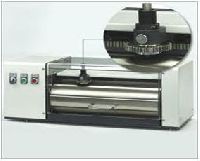
footwear testing equipment
It consists of test specimen holder with a cylindrical opening adjustable between 15.5 to 16.3 mm to clamp the test specimen with an arrangement to adjust the length of test specimen protruding out. The holder is mounted by a screw mechanism along a length of a rotating drum on which the abrasive cloth is fixed. The movement to the screw mechanism and drum is given by an electric motor, gearbox and chain mechanism to give the specified speed of rotation to the drum and the specified lateral movement to the test specimen holder. The swivel arm and test specimen holder are so disposed that the test specimen is pressed against the drum under the specified load with its center axis at an inclination of 3 degree to the perpendicular in the direction of rotation and placed above the longitudinal axis of drum. A rack and pinion arrangement to rotate the test specimen about its axis during the test (whenever desired) is also provided. The abrasive cloth is firmly fixed to the drum using a suitable peel able adhesive with the ends of the abrasive cloth butt jointed together.
...more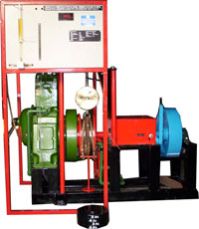
Diesel Engine Test Rig
Two main components from main parts of the test rig. Welded steel base plate, complete with Rope Brake Dynamometer provided with cooling water arrangement. Panel board positioned over the base plate consisting of fuel system with flow measurement by burette, air flow measurement system, temperature and speed indicator.
...more
Crimp Rigidity Tester
Crimp Rigidity of a textured yarn gives a measure of its ability to recover from stretch. It is determined by measuring the percentage reduction of length of a skein of yarn immersed in water when a minor load replaces a major load. For measuring crimp rigidity, a skein of known number of strands is prepared from the package of yarn under test. This skein is then immersed in water filled in a glass jar with a load of 0.1 gdenierstrand suspended on it. The length of the skein is measured on a scale. The load is then reduced to 0.002 gdenierstrand by replacing the major load by the minor load and the reading on the scale observed. Crimp rigidity is calculated from the readings obtained under the major and minor loads
...more
civil engineering lab equipments
This is a brass tube approximately 53cm long and 2.8 cm I.D. with a wooden handle. Total length approximately 73cm. The tube hasthe sharp angular edge which conveniently pierces cement bags. An air hole of approximately 3mm die is drilled on the tube neahandle. Total sample collected at one time is 300cm 3 approximately.
...more
Capping Set
For correct compressive strength of concrete cylinders, the end surfaces of the specimen must be truly flat. If they are not, using capping compound and a capper, the faces are plastered flat. Capping set can be used for cylindrical specimen likeconcrete cylinders of cores. They can be used in Laboratory or in field.
...more
Bitumen Testing Machine
This is apparatus is used to determine softening point of bitumen, Ring and ball apparatus is used to determine softening point. It is that temperature at which a sample of bituminous material loaded by a 9.5mm dia.-steel ball, drops at a distance of 25mm. The apparatus consists of steel bracket with a sliding plate support. That support has two holes of 10mm dia. on which a Ring and Ball guide can be kept. A central Hole on this plate is for inserting thermometer. Supplied with a glass beaker approximate 8.5cm I.D., 12cm high and a hand stirrer and 2 nos. 9.5mm dia. steel balls.
...more
Air Conditioning Test Rig
This Laboratory scale working model housed on a M.S. Square tube frame further mounted on a wheels (CI) with nstrumentation panel is used i) To study the Vapour compression Cycle ii) To calculate co-efficient of performance (COP) iii) To evaluate tonnage capacity.
...more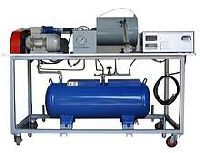
Air compressor test rig
Single Stage, Single Cylinder air compressor with a displacement capacity of about 150 LPM and to work against maximum pressure 8KgCm2 The Unit is mounted on a storage tank. The Unit is supplied with pressure switch, suction filter safety valve, pressure gauge, water drain valve air delivery valve etc. An orifice tank with orifice plat, manometer with pressure tapings are provided to measure the volume of air sucked by the compressor. Digital temperature indicator to measure suction and delivery side temperature of the compressor. Pressure gauges to measure stage pressure. Send Enquiry
...moreBe first to Rate
Rate This